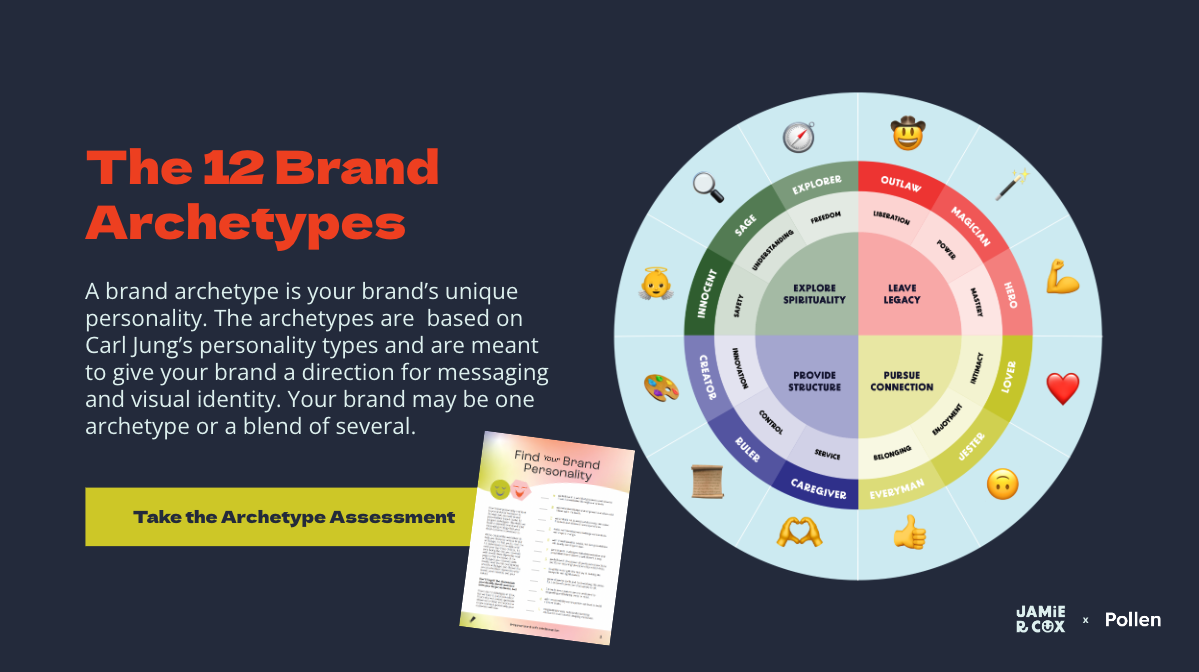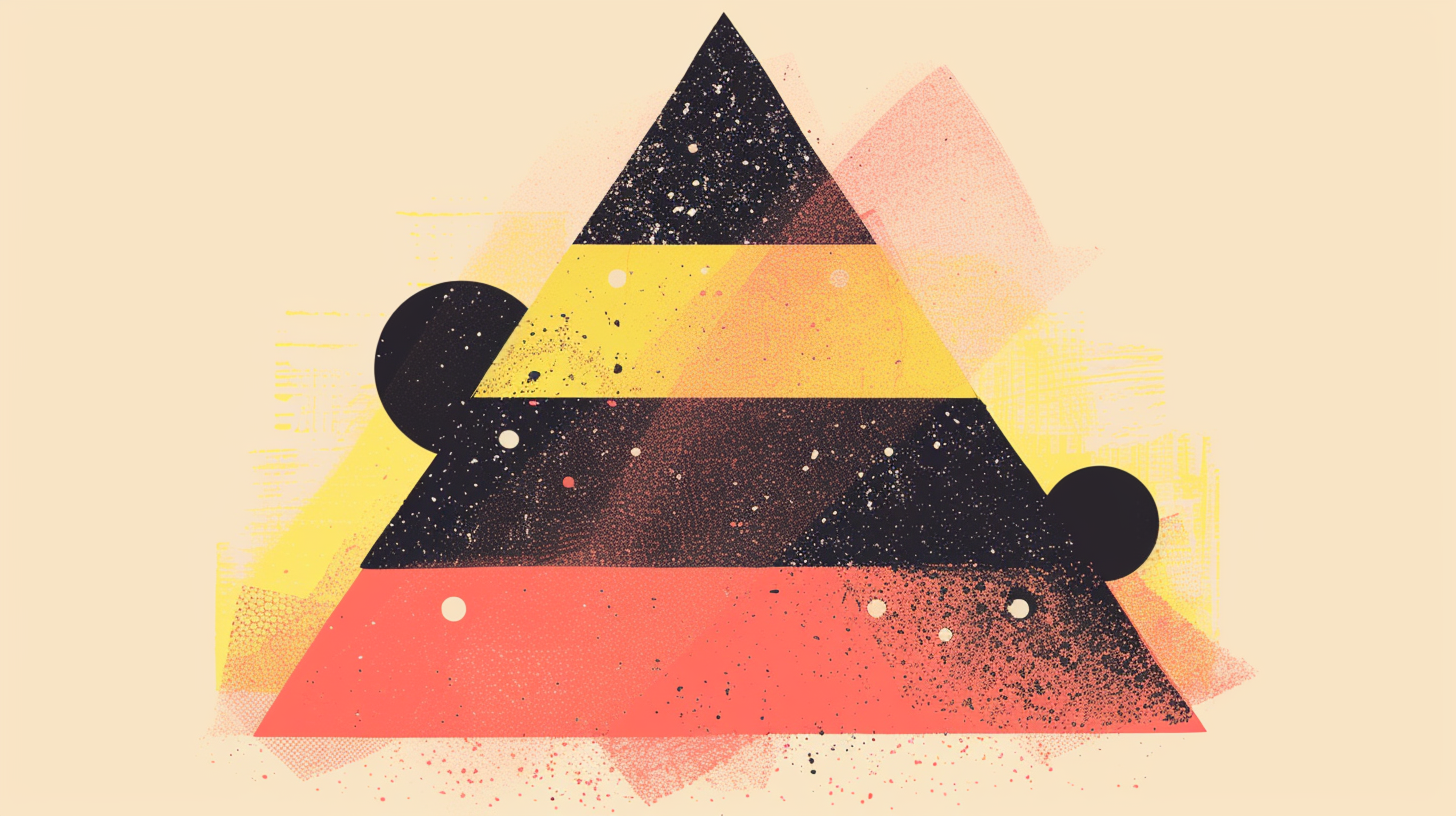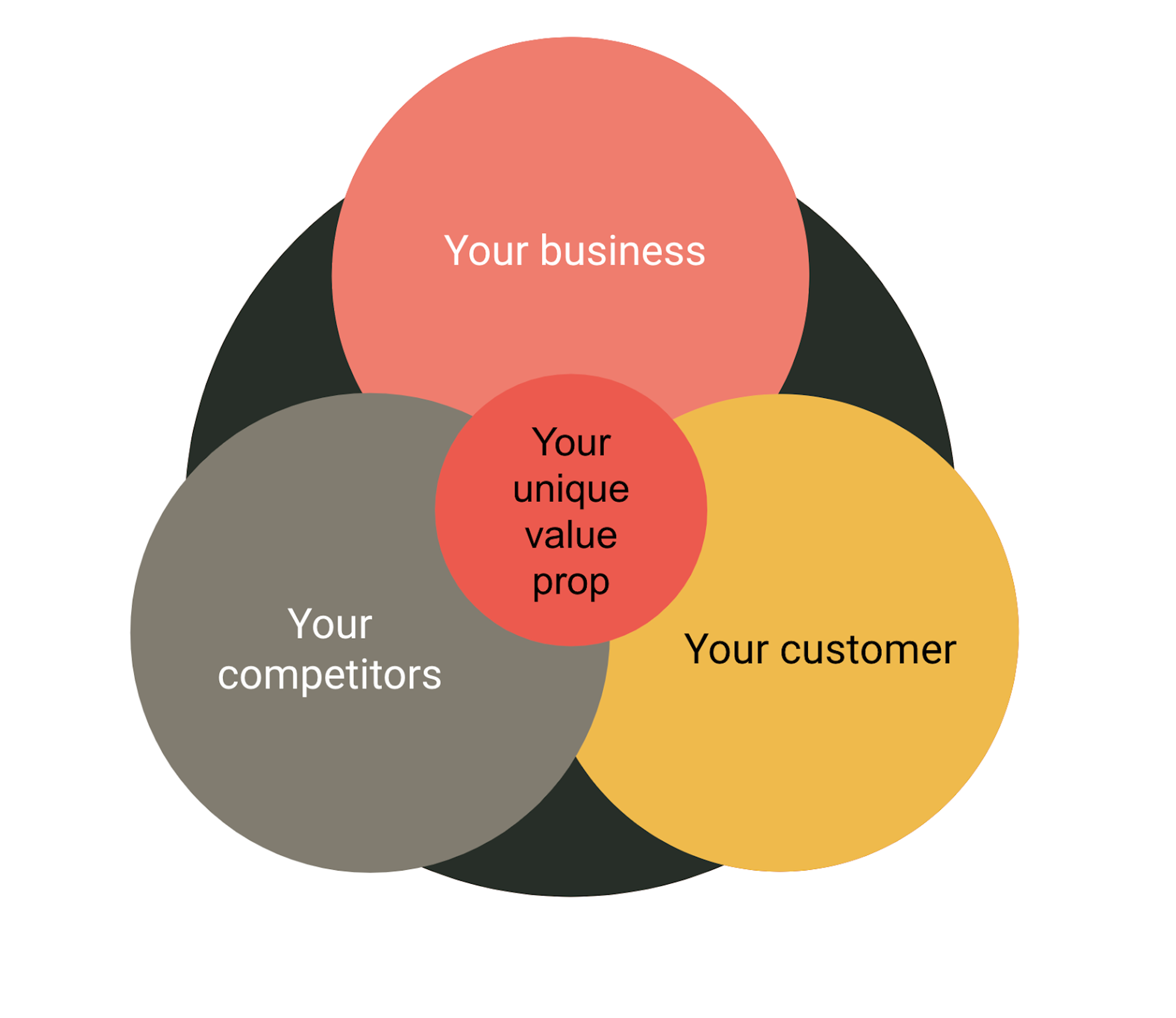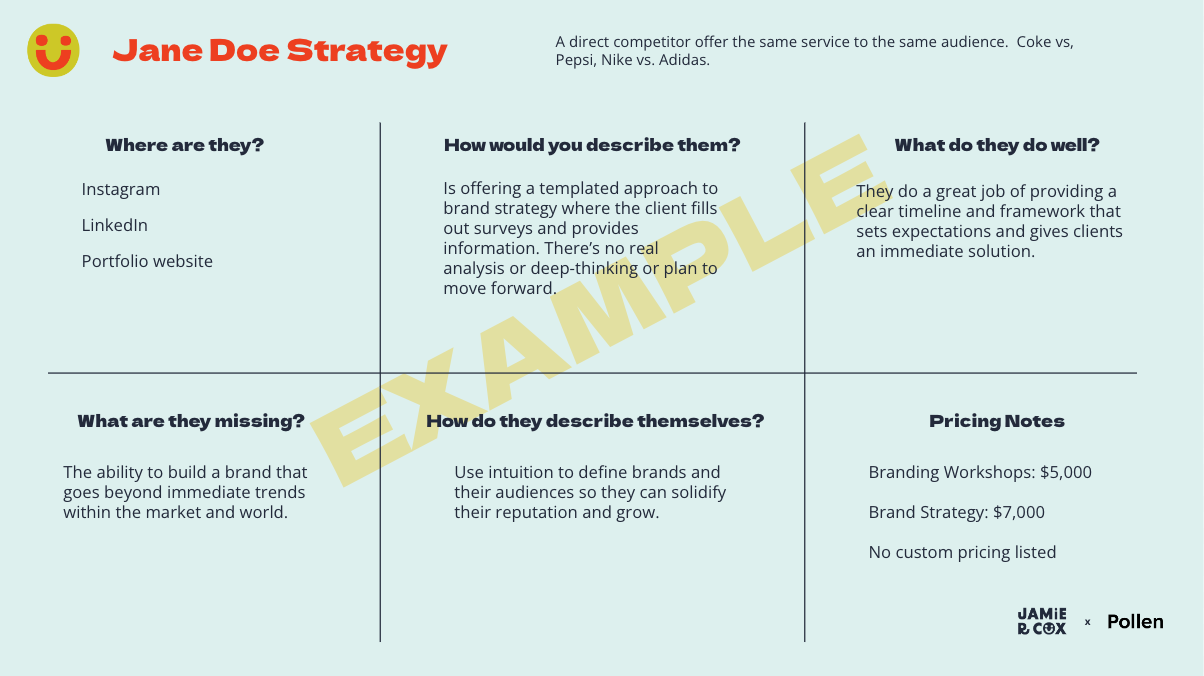Identify Your Brand Archetype
In the early 20th century, psychoanalyst Carl Jung outlined 12 distinct personality types. These high-level personalities, or archetypes, summarized recurring patterns as a way to organize basic human behavior.
For brands, archetypes are a shorthand way to understand how you want to show up in the world and who you want to connect with. Identifying yours can be a revelatory thought experiment that will help you define your brand personality and ultimately build more effective messaging and a resonant visual identity.
Below, you’ll find the 12 brand archetypes inspired by the Jungian model. As you read through them, note which feels like a natural fit for your brand—and for your clients. Ask yourself: Who do you want to be, and who does your ideal customer need in their life? If several feel aligned, note the aspects that are most—and least—resonant within each.

1. The Outlaw
Outlaws are rebels and rule-breakers who thrive on pushing boundaries and challenging norms. They embody defiance, disruption, and a fearless attitude.
- Goal: Liberation
- Core belief: Rules are meant to be broken
- Strategy: Challenge the status quo
- Language: Provocative, edgy, defiant
- Visuals: Bold and unconventional
- Example brands: Harley Davidson, Virgin Atlantic
2. The Magician
Magicians are visionaries who embrace transformation. They inspire with their belief that anything is possible, weaving enchantment and magic into every aspect of their brand.
- Goal: Transforming reality
- Core belief: Anything is possible
- Strategy: Inspire and enchant
- Language: Visionary, imaginative, inspiring
- Visuals: Whimsical, detailed, dreamlike
- Example brands: Disney, Apple
3. The Hero
Heroes are brave and determined, facing challenges head-on with a goal of triumph and victory. They embody strength, resilience, and the spirit to overcome obstacles.
- Goal: Overcoming challenges
- Core belief: Where there's a will, there's a way
- Strategy: Strive for success and victory
- Language: Bold, empowering, heroic
- Visuals: Strong, dynamic, stark
- Example brands: Nike, FedEx
4. The Lover
Lovers are passionate and sensual, connecting with audiences on an emotional level. They believe in the transformative power of love and aim to create deep, intimate connections.
- Goal: Deep connections and pleasure
- Core belief: Love makes the world better
- Strategy: Create emotional bonds
- Language: Thoughtful, emotional, indulgent
- Visuals: Warm, rich, textured
- Example brands: Chanel, Godiva Chocolatiers
5. The Jester
Jesters bring playfulness and humor to the forefront, celebrating spontaneity and lighthearted joy. They believe in the power of laughter as a universal remedy, infusing their brand with lively, entertaining energy.
- Goal: Enjoy the moment, have fun
- Core belief: I’m here for a good time
- Strategy: Bring joy and humor
- Language: Playful, entertaining, positive
- Visuals: Whimsical, colorful, lively
- Example brands: Skittles, Old Spice
6. The Everyman
Everymen are relatable, down-to-earth, and genuine. They connect with audiences through shared experiences. They believe in the strength of unity, emphasizing commonality and simplicity in their approach.
- Goal: Belonging and connection
- Core belief: We're all in this together
- Strategy: Relate to universal experiences
- Language: Approachable, relatable, casual
- Visuals: Everyday, neutral, representational
- Example brands: Budweiser, Walmart
7. The Caregiver
Caregivers are nurturing and compassionate, focusing on the well-being of others. Rooted in the belief that love heals, they aim to provide support and comfort, fostering a sense of care and understanding.
- Goal: Caring for others' well-being
- Core belief: Love heals all wounds
- Strategy: Provide support and nurture
- Language: Compassionate, empathetic, supportive
- Visuals: Comforting, calm, warm
- Example brands: Johnson + Johnson
8. The Ruler
Rulers are authoritative and organized, aspiring to establish order and prosperity. They believe in the power of control and structure to lead their kingdom to success.
- Goal: Establishing a prosperous world
- Core belief: Control brings order and success
- Strategy: Create order and structure
- Language: Authoritative, organized, direct
- Visuals: Sophisticated, organized, powerful
- Example brands: Rolex, Starbucks
9. The Creator
Creators are innovative and imaginative, driven by the desire to express their unique vision. They believe in the transformative impact of creativity, pushing boundaries to craft something truly extraordinary.
- Goal: Expressing creative vision
- Core belief: Create something unique
- Strategy: Innovate and inspire creativity
- Language: Imaginative, creative, inspiring
- Visuals: Artistic, inventive, colorful
- Example brands: Lego, Adobe
10. The Innocent
Innocents are pure and optimistic, embracing a childlike joy and simplicity. They believe in the world's inherent goodness and aim to spread happiness and positivity.
- Goal: To be happy and fulfilled
- Core belief: The world is good
- Strategy: Simplify and bring joy
- Language: Optimistic, pure, simple
- Visuals: Clean, simple, tranquil
- Example brands: Aveeno
11. The Sage
Sages are wise and reflective, seeking knowledge and understanding. They believe in the liberating power of truth and share insights and wisdom with their audience.
- Goal: Attaining wisdom and understanding
- Core belief: The truth will set you free
- Strategy: Share knowledge and insight
- Language: Wise, reflective, insightful
- Visuals: Sophisticated, intentional, informative
- Example brands: National Geographic, TED
12. The Explorer
Explorers are adventurous and independent, driven by curiosity and a desire to discover new horizons. They embody the spirit of exploration, encouraging others to embrace the unknown with a daring attitude.
- Goal: Discovering new horizons
- Core belief: Don't fence me in
- Strategy: Embrace the spirit of adventure
- Language: Curious, ambitious, exploratory
- Visuals: Natural, adventurous, bold
- Example brands: GoPro, Jeep
In the early 20th century, psychoanalyst Carl Jung outlined 12 distinct personality types. These high-level personalities, or archetypes, summarized recurring patterns as a way to organize basic human behavior.
For brands, archetypes are a shorthand way to understand how you want to show up in the world and who you want to connect with. Identifying yours can be a revelatory thought experiment that will help you define your brand personality and ultimately build more effective messaging and a resonant visual identity.
Once you’ve selected your archetype, the next step is to outline how you want to show up as that archetype. This will shape how your customers perceive you.
Use the following template, making note of the characteristics of each archetype you identify with—the positives and the negatives. Then, distill those perceptions into broader personality traits that get to the heart of how you work and what you bring to each interaction.

How to blend archetypes together
If your brand doesn’t fit squarely into one archetype, or if you feel that one archetype may limit the audience you connect with, fear not: you can blend them.
Here are a couple of questions to consider:
1. What pieces of me can I bring to this to make it a great fit?
The goal is not to shapeshift for every new client but rather to find that space between your personality and the type of consultant your client needs to solve their problem. You want to bring an energy to client relations that feels natural for you but also like a win for them.
2. How can I offset some of my dominant traits to be a better fit? Say you’ve got heavy Sage vibes going on but don’t want to be perceived as stuffy or overly professorial. You might consider infusing your intellectual instincts with the levity of a Jester or the laid-back approachability of an Everyman.
For example, I like to blend the Jester and the Outlaw archetypes into what I call the "Renegade Riddler." I’ve outlined the personality traits core to this blended archetype, and the ways in which I do and don’t want my clients to perceive my approach.

To zero in on your top three best-fit archetypes, read the following list of statements. Rank the top three that resonate with you—and that you expect will resonate with your audience.
- We believe in a world of goodness and strive to make it even better through our actions. [The Innocent]
- We value knowledge and empower ourselves and others with the truth. [The Sage]
- We embark on journeys of discovery. We value freedom and embrace new experiences. [The Explorer]
- Rules don’t bind us; we challenge conventions and inspire change. [The Outlaw]
- With transformative power, we turn possibilities into reality and inspire awe. [The Magician]
- We conquer challenges with determination and prove that where there’s a will, there’s a way. [The Hero]
- We believe in the power of profound connections and foster meaningful relationships [that] enrich lives. [The Lover]
- Laughter is our gift. We find joy in making life enjoyable and lighthearted. [The Jester]
- We’re down-to-earth and hard-working. We strive for a sense of connection that speaks to all. [The Everyman]
- Caring is in our nature; we are dedicated to supporting and helping those in need. [The Caregiver]
- With responsibility comes power; we lead to build a better world. [The Ruler]
- Imagination knows no bounds; we bring innovative visions to life, shaping the future. [The Creator]
Review your top three archetypes, and choose the one (or two or three) that feels like you while also feeling like someone your client needs in their life. If you land on more than one, skip down to the “blending archetypes” section.
independent consulting business to the next level.







